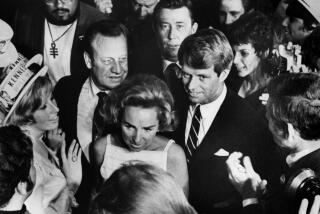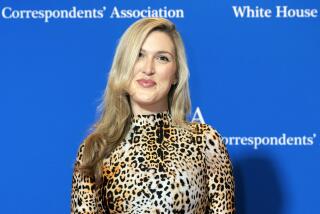Pierre Salinger, 79; Press Secretary for Kennedy, Longtime ABC Reporter
- Share via
Pierre Salinger, the bushy-browed, cigar-chomping journalist who served as press secretary for Presidents Kennedy and Johnson and spent more than a decade as ABC News’ chief correspondent in Europe, died Saturday. He was 79.
Salinger, who was briefly a U.S. senator from California in 1964 and became known as “Mr. America” in France during his many years as a Paris-based journalist, died at a hospital in Cavaillon, a town in the Provence region of France. Salinger, who had been in failing health for the last few years, suffered a heart attack, according to his son, Stephen.
Salinger won a Peabody Award and an Overseas Press Club award for a three-hour 1981 documentary on the secret efforts to free the American hostages in Iran after the takeover of the U.S. Embassy in Tehran.
In 1991, he obtained exclusive interviews with the two Libyan suspects in the bombing of Pan Am Flight 103, which had exploded over Lockerbie, Scotland, in 1988, killing 270 people. He was the prosecution’s final witness at the men’s 2000 trial.
Salinger also made news -- and subjected himself to criticism -- in 1996 with his claim that TWA Flight 800 was inadvertently shot down by a Navy missile soon after taking off from New York’s John F. Kennedy International Airport, and that the government was conspiring to cover it up.
Salinger and others had obtained a videotape of the radar at JFK. He believed it showed a missile heading toward Flight 800 just before the jetliner exploded. But federal investigators called Salinger’s accusation of a cover-up outrageous and dismissed the images, saying there was no evidence of a missile tracking toward the aircraft.
The FBI investigation later concluded that the jumbo jet crashed after a fuel tank exploded for unknown reasons.
For all his years in the public eye as a journalist, Salinger once noted that people recognized him because he had worked for Kennedy.
A former investigative reporter for the San Francisco Chronicle and Collier’s magazine who worked for Robert F. Kennedy as an investigator with the U.S. Senate’s select committee to probe labor-management racketeering in the late 1950s, Salinger became then-Sen. John Kennedy’s campaign press secretary in 1959.
In November 1960, after a hard-fought presidential campaign against Richard M. Nixon, President-elect Kennedy appointed Salinger as his White House press secretary. At 35, Salinger was the youngest person to ever hold the position.
Reflecting the youthful vigor of the youngest president in the nation’s history, Salinger revitalized presidential media relations. Just weeks before Kennedy was sworn in, Salinger announced a major innovation: presidential news conferences on live television.
“This would give the whole nation a chance to see the president as he actually answers the questions of reporters,” Salinger said at the time. “We think it would be beneficial to the press.”
Then, with a nod to Kennedy’s appeal as demonstrated in the now-legendary Kennedy-Nixon debates, Salinger added: “And, indeed, we think it would be beneficial to all concerned.”
Salinger also turned the White House into an open beat: Reporters could interview any member of the White House staff on any subject without first having to clear it with the press secretary. In addition, he eliminated the rule that if one reporter got a story, all reporters got it.
“There had been a practice back to the days of Steve Early [President Franklin D. Roosevelt’s press secretary] that everyone got the same information,” he said in a 1974 interview with The Times. “That tended to turn reporters into robots sitting around waiting for you to tell them something. It was healthier if they could get the news on their own.”
Early in his stint at the White House, Salinger said, he faced the problem of the administration withholding information from him during planning for the Bay of Pigs incident, the failed 1961 invasion of Cuba designed to overthrow Fidel Castro.
“I was completely shut out of the Bay of Pigs,” Salinger told The Times in 1990. “I didn’t learn about the invasion until three hours before it happened. It made dealing with the press very difficult.
“During a crisis, a press secretary has to be involved in the inner discussions, so he knows what can be said and what can’t be said.”
In the 1974 Times interview, Salinger said that when the Bay of Pigs incident was over, “I went to the president and said I couldn’t operate that way. My effectiveness would be destroyed unless I knew about even the most covert operations of government. He agreed and it never happened again.”
Indeed, during the Cuban missile crisis in 1962, Salinger was present at all key planning meetings, which allowed him to effectively deal with the media, he said.
During his time in the White House, Salinger played a far greater role than press secretaries in most administrations. And thanks to television, he became one of the most recognizable of JFK’s New Frontiersmen.
The dark-haired, poker-playing Salinger was described in the press at the time as being sharp, brash and witty; a hard-driving, swarthy cherub who talked rapidly in short bursts; and a bon vivant who loved good wine, good food and good cigars.
But, as Salinger wrote in “With Kennedy,” his 1966 memoir, at “5-feet-9 and 20 pounds overweight,” he was “clearly not a fit representative of the New Frontier.” Indeed, when Kennedy saw Herb Klein, Nixon’s press secretary, announcing the concession of the election on television, the victor took note of the trim and sharply tailored Klein, and told Salinger, “He looks more like a New Frontiersman than you do.”
Salinger was flying with Secretary of State Dean Rusk and other Cabinet members to Japan when they received word that Kennedy had been assassinated in Dallas on Nov. 22, 1963. Salinger later viewed his time with the president as the best years of his life.
“What could be better than getting up in the morning, going to the White House, working with a man like John Kennedy, having the feeling that you’re contributing to decisions affecting your country,” he told the Chicago Tribune in 1979. “It was incredible.”
The first of four sons, Pierre Emil George Salinger was born in San Francisco in 1925.
His Jewish American father was a mining engineer who had co-founded a symphony orchestra in Salt Lake City. His French-born Catholic mother was editor in chief of a daily newspaper for San Francisco’s French community.
A piano prodigy, young Pierre played his first concert at the age of 6, impressing an audience with a Haydn sonata at the International Exposition in Toronto, where the family had moved in 1929 and lived for a few years.
Salinger also was academically precocious. Privately tutored and with a 140 IQ, he entered high school at age 11 after the family returned to San Francisco. He graduated in 1941 and, barely 16, entered San Francisco State, where he edited the campus newspaper and worked nights as a copy boy at the Chronicle.
His work and studies were interrupted in 1943, when he was sworn into the Navy a few days short of his 18th birthday. He eventually became commander of a 110-foot submarine chaser that accompanied slow-moving tankers in the Pacific. He was later awarded the Navy and Marine Corps Medal for helping rescue six seamen trapped on a reef in Okinawa harbor during a typhoon.
After the war, Salinger studied history at the University of San Francisco and worked nights at the Chronicle. As an investigative reporter, he disguised himself as a vagrant drunk and wrote an award-winning series exposing jail conditions. Another investigative series led to a statewide cleanup of illegal practices in California’s bail-bond system.
In 1955, Salinger became West Coast editor of Collier’s magazine. While writing a series of articles on corruption in the Teamsters union, he met Robert Kennedy, who became counsel to the Senate subcommittee charged with investigating labor racketeering.
Collier’s folded before Salinger’s articles could be published, but his research material was used by RFK in the Senate probe and, in 1957, Kennedy hired Salinger as the first staff investigator of what became known as the Senate Rackets Committee.
While working with the committee, Salinger met JFK, one of its leading members.
After President Kennedy was assassinated, Salinger continued as Johnson’s White House press secretary. Four months later, he resigned to run as a candidate in the Democratic senatorial primary in California. Incumbent Sen. Clair Engle was considered a shoo-in for reelection, but he had undergone surgery for a brain tumor and the prognosis was not good.
Salinger won the Democratic nomination against then state Controller Alan Cranston. After Engle died in late July, Gov. Edmund G. “Pat” Brown appointed Salinger to complete the final months of Engle’s term.
In the November general election, Salinger was defeated by the Republican nominee, former film actor George Murphy.
In early 1968, Salinger went to work for Robert Kennedy’s presidential campaign. That June, Salinger was only yards from Kennedy when the senator was fatally shot by Sirhan Sirhan in the pantry of the Ambassador Hotel in Los Angeles.
Salinger moved to Paris, but returned to the U.S. in 1972 to co-chair the National Citizens for McGovern Committee. Moving back to France after Sen. George McGovern’s defeat, he returned to journalism as a contributor to the French newsweekly L’Express in Paris.
In 1976, Salinger’s friend Roone Arledge, then president of ABC Sports, asked him to do human-interest stories as part of the network’s coverage of the Winter Olympics in Austria. In 1978, Salinger became a full-time correspondent.
After leaving ABC News in 1993, he served three years as vice chairman of Burson Marsteller, a large international public relations firm.
Salinger’s first three marriages ended in divorce.
In addition to his son, Stephen of Los Angeles, he is survived by another son, Gregory of Paris; his wife, the former Nicole Beuvillain; and five grandchildren.
More to Read
Sign up for Essential California
The most important California stories and recommendations in your inbox every morning.
You may occasionally receive promotional content from the Los Angeles Times.










